Blog by Steve Laug
In my previous blog on the No Name Meerschaum I spoke of the five pipes that I am working on for Craig. In this blog I am taking on the second of his pipes – a leather clad billiard marked R20. It looks like a Longchamp pipe but there is no name on the shank. Here is what Craig wrote me about his pipes: I was recently given a bag of pipes…literally, a BAG of 20 or so pipes that are 50+yrs in age and VERY used. I was wondering if you would have time to either Skype or FaceTime with me, and go through what I have in order to determine which are worth sending to you to have them refurbished. If you would be so kind, I’d really appreciate it. We met on FaceTime and walked through each of the pipes in his bag. He pulled out a grocery bag with no rhyme or reason to it. It was filled with a jumble of no name or low-end drug store pipes. The only pipes that stood out for me were an old WDC Campaign pipe and a Grabow Starfire. We excluded all but five of the pipes. The amount of work necessary to bring them back was not worth the price. These are the five that we chose to work on. As I finish them, I will include the link to the blog covering that pipe.
- A No Name Meerschaum that looked interesting – https://rebornpipes.com/2018/01/31/is-it-a-meerschaum-looks-like-one-feels-like-one-but/
- A leather clad billiard marked R20 and bearing a shield
- A Dr. Grabow Starfire 39 that had great grain
- A WDC Campaign underslung pipe
- A Wally Frank Bulldog marked Natural Unvarnished lacking a stem
After our conversation, he packed up the pipes and threw the rest of the pipes in a separate bag for me to scavenge parts. The box did not take too long to get to Vancouver and when it did I opened the box and had a look. Here are pics of what I saw – there were two bags inside. One bag held the discards for the scrap pile and the other held the five pipes he wanted restored.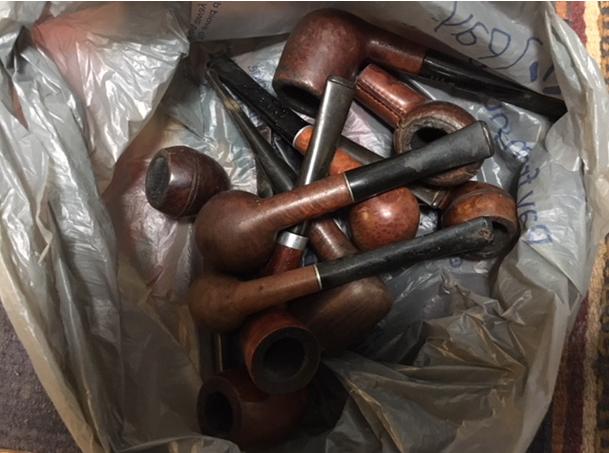
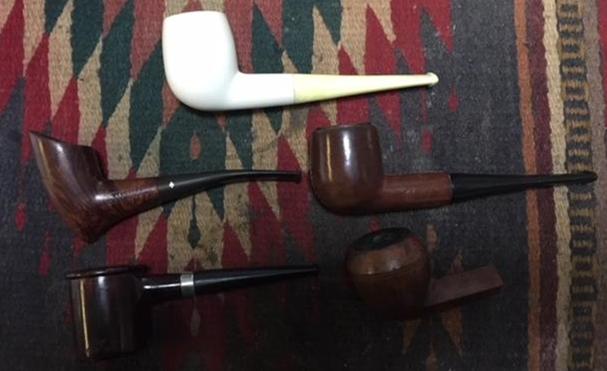 The second pipe was the leather-clad billiard. The leather was dry and dirty but the stitching holding the halves together was sound and undamaged. A little leather soap or oil would bring it back to life. The rim top had been hammered against a hard surface to knock out the dottle and there was serious road rash on the surface of the rim. The outer edges were damaged all around the bowl but predominantly on the right side. There was some darkening on the rim as well. The bowl had a thin cake in it and remnants of tobacco. The leather cover had scuff marks around the sides near the top. The only identifying mark was what looked like the shape of a tanned hide (cowhide or other) stamped into the left side of the shank. There were no other identifying marks on the left side. On the right side was the stamping R20 which I am assuming was the shape number. The stem was vulcanite and it had nicks half way up the stem and tooth marks and chatter on both sides near the button. The surface was dirty and dull looking but thankfully not oxidized. There was a corkscrew like stinger apparatus in the tenon that was clogged and I could not even blow air through the slot or stem. The slot itself also had tars built up reducing the size of the slot by half. The pipe smelled like the same Half and Half tobacco as the other pipe. The tobacco leaves behind a ghost of an anise smell that clings to a pipe that has smoked that blend. I took the following photos of the pipe before I started cleaning it up.
The second pipe was the leather-clad billiard. The leather was dry and dirty but the stitching holding the halves together was sound and undamaged. A little leather soap or oil would bring it back to life. The rim top had been hammered against a hard surface to knock out the dottle and there was serious road rash on the surface of the rim. The outer edges were damaged all around the bowl but predominantly on the right side. There was some darkening on the rim as well. The bowl had a thin cake in it and remnants of tobacco. The leather cover had scuff marks around the sides near the top. The only identifying mark was what looked like the shape of a tanned hide (cowhide or other) stamped into the left side of the shank. There were no other identifying marks on the left side. On the right side was the stamping R20 which I am assuming was the shape number. The stem was vulcanite and it had nicks half way up the stem and tooth marks and chatter on both sides near the button. The surface was dirty and dull looking but thankfully not oxidized. There was a corkscrew like stinger apparatus in the tenon that was clogged and I could not even blow air through the slot or stem. The slot itself also had tars built up reducing the size of the slot by half. The pipe smelled like the same Half and Half tobacco as the other pipe. The tobacco leaves behind a ghost of an anise smell that clings to a pipe that has smoked that blend. I took the following photos of the pipe before I started cleaning it up.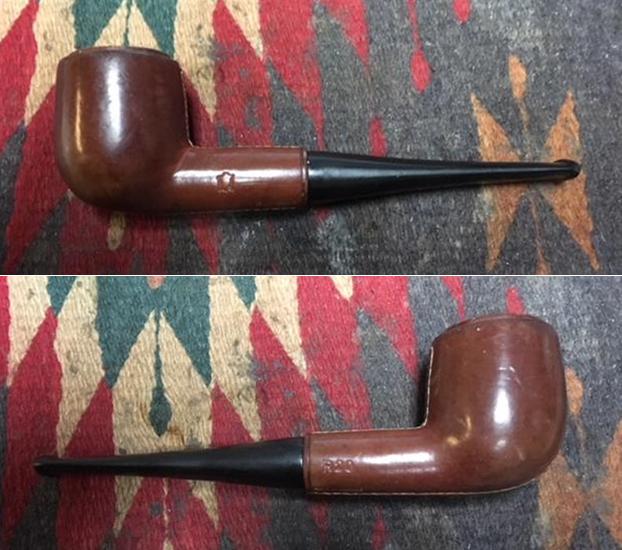
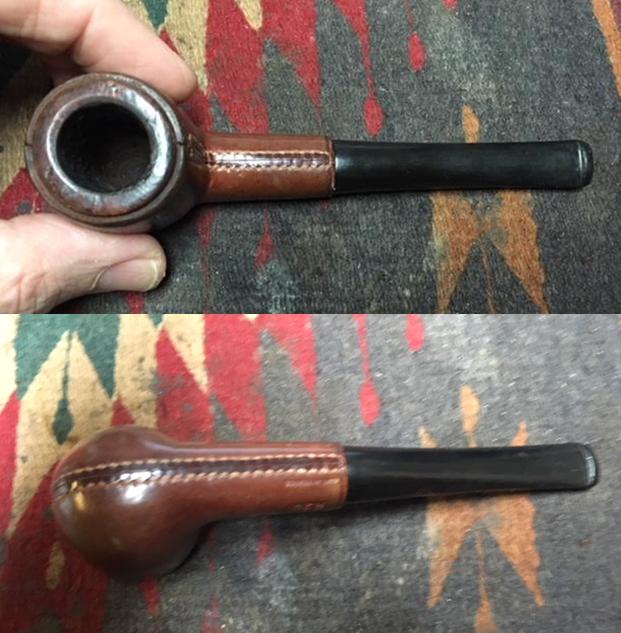 I took close up photos of the bowl and rim top as well as the stem. The rim top had been beaten on a hard surface to knock out the dottle and there were some serious nicks and dents in the surface. There was some overflow on the rim. The stem was another story – it was in decent shape with tooth marks and chatter on both sides near the button. There was a metal tenon like a spear tip on the end of the stem. It was very dirty.
I took close up photos of the bowl and rim top as well as the stem. The rim top had been beaten on a hard surface to knock out the dottle and there were some serious nicks and dents in the surface. There was some overflow on the rim. The stem was another story – it was in decent shape with tooth marks and chatter on both sides near the button. There was a metal tenon like a spear tip on the end of the stem. It was very dirty. I decided to top the damaged portion of the bowl to remove the rough top of the bowl. It did not take too much sanding to remove the damaged inner and outer edges of the rim as well as the surface. Once it was smooth and even all the way around I finished the topping.
I decided to top the damaged portion of the bowl to remove the rough top of the bowl. It did not take too much sanding to remove the damaged inner and outer edges of the rim as well as the surface. Once it was smooth and even all the way around I finished the topping.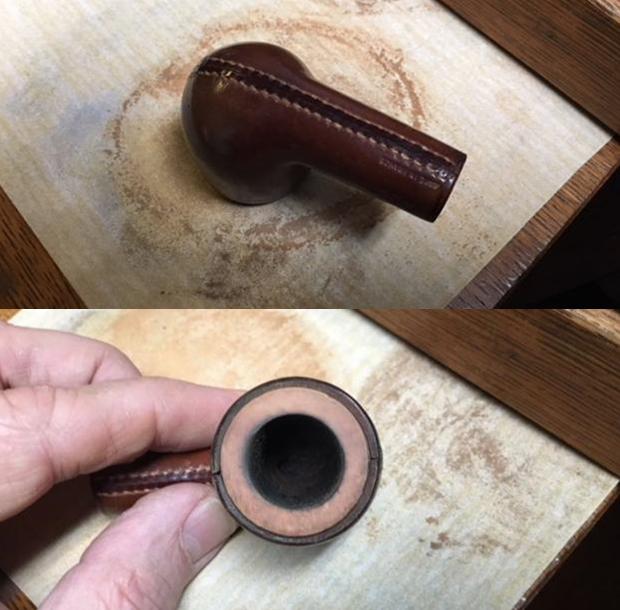 I used a Savinelli Fitsall Pipe Knife to clean out the cake and tobacco remnants from the bowl. As I worked on it I was again certain that the tobacco of choice to the pipeman who had smoked the pipe in the past was Half and Half.
I used a Savinelli Fitsall Pipe Knife to clean out the cake and tobacco remnants from the bowl. As I worked on it I was again certain that the tobacco of choice to the pipeman who had smoked the pipe in the past was Half and Half.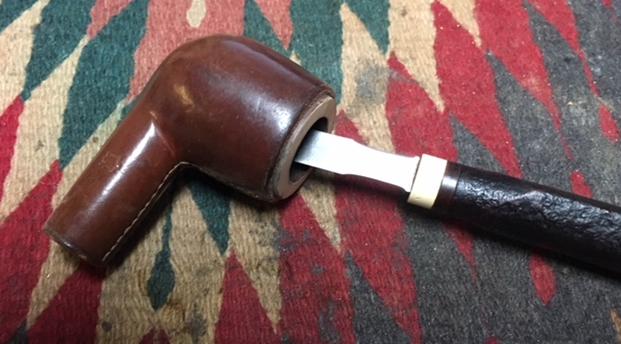 I polished the rim top with micromesh sanding pads – wet sanding with 1500-2400 grit pads and dry sanding with 3200-12000 grit pads. I polished the rim until it was smooth and shiny. I wiped the rim top down with a damp cotton pad to remove any sanding dust.
I polished the rim top with micromesh sanding pads – wet sanding with 1500-2400 grit pads and dry sanding with 3200-12000 grit pads. I polished the rim until it was smooth and shiny. I wiped the rim top down with a damp cotton pad to remove any sanding dust.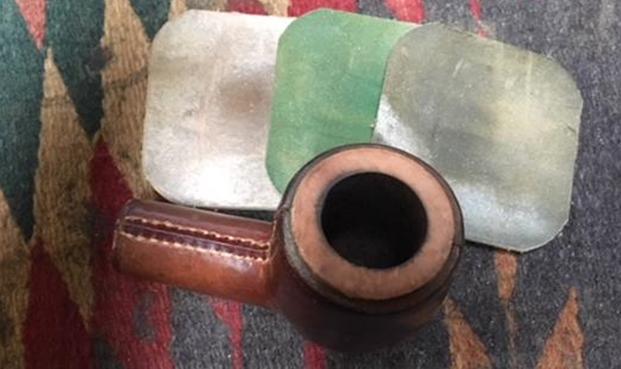

 I scrubbed the surface of the briar with Before & After Restoration Balm. I worked it into the rim top with my fingers and it raised the grime and dust that was in the grain of the briar. I buffed it with a soft cotton cloth to remove the debris and the remaining balm on the surface of the briar. When it was clean I stained the rim top with a medium brown stain pen to match the colour of the leather and the blend it with the rest of the pipe. The rim would still need to be buffed to smooth out the colour of the rim.
I scrubbed the surface of the briar with Before & After Restoration Balm. I worked it into the rim top with my fingers and it raised the grime and dust that was in the grain of the briar. I buffed it with a soft cotton cloth to remove the debris and the remaining balm on the surface of the briar. When it was clean I stained the rim top with a medium brown stain pen to match the colour of the leather and the blend it with the rest of the pipe. The rim would still need to be buffed to smooth out the colour of the rim.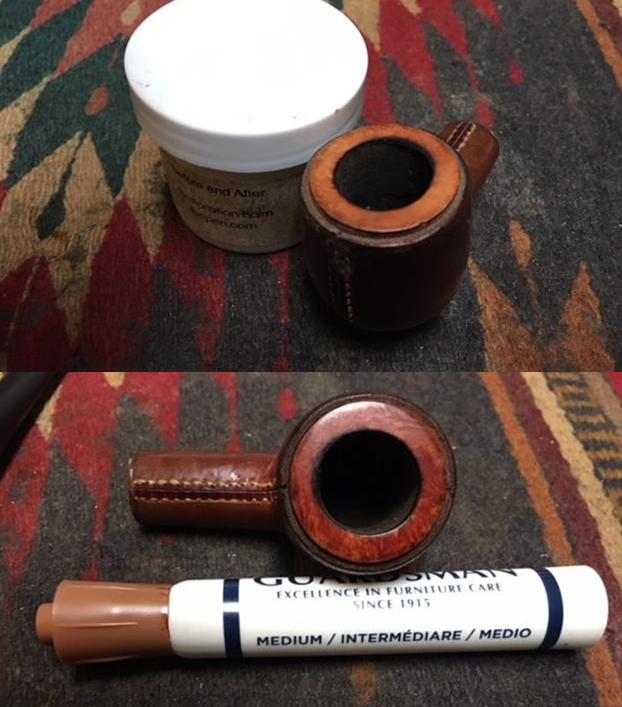 I decided to try out the restoration balm on the leather cover of the pipe. I worked it into the pores of the leather to clean and enrich it. I was amazed at how well it worked. It lifted the grime to the surface and I was able to wipe it off with a clean cotton pad. I worked it into the grain of the leather until the leather was soft and pliable. I worked it into the cotton cord that held the halves of the leather cover together. It worked very well.
I decided to try out the restoration balm on the leather cover of the pipe. I worked it into the pores of the leather to clean and enrich it. I was amazed at how well it worked. It lifted the grime to the surface and I was able to wipe it off with a clean cotton pad. I worked it into the grain of the leather until the leather was soft and pliable. I worked it into the cotton cord that held the halves of the leather cover together. It worked very well.
 The corkscrew stinger was threaded as I expected. I unscrewed it from the shank to remove it. It was clogged with tars and oils in the slot and in the stem. I could not blow air through the stem as the debris clogged it. I would clean up the stinger and leave it out of the tenon. I would send it back to Craig and he could do what he wanted.
The corkscrew stinger was threaded as I expected. I unscrewed it from the shank to remove it. It was clogged with tars and oils in the slot and in the stem. I could not blow air through the stem as the debris clogged it. I would clean up the stinger and leave it out of the tenon. I would send it back to Craig and he could do what he wanted. I cleaned out the mortise and the airways in the shank and stem with alcohol, pipe cleaners and cotton swabs. Both were very dirty and as the pipe cleaners and cotton swabs came out they reeked of Half and Half tobacco. It was strong smelling. It took a while to get rid of all the tars and the oils in the vulcanite and the briar. I used a lot of pipe cleaners, cotton swabs and alcohol before the airways in the stem and shank and the mortise were clean.
I cleaned out the mortise and the airways in the shank and stem with alcohol, pipe cleaners and cotton swabs. Both were very dirty and as the pipe cleaners and cotton swabs came out they reeked of Half and Half tobacco. It was strong smelling. It took a while to get rid of all the tars and the oils in the vulcanite and the briar. I used a lot of pipe cleaners, cotton swabs and alcohol before the airways in the stem and shank and the mortise were clean. With the stem cleaned on the outside it was time to work on the outside of the vulcanite. There were tooth marks near the button on both sides and there were deep nicks on the top of the stem about half way up. I filled in the spots with clear super glue and overfilled it. I started to smooth out the repairs and then remembered that I had not photographed the filled in areas. So the photos below show the stem midway in the process of sanding it.
With the stem cleaned on the outside it was time to work on the outside of the vulcanite. There were tooth marks near the button on both sides and there were deep nicks on the top of the stem about half way up. I filled in the spots with clear super glue and overfilled it. I started to smooth out the repairs and then remembered that I had not photographed the filled in areas. So the photos below show the stem midway in the process of sanding it.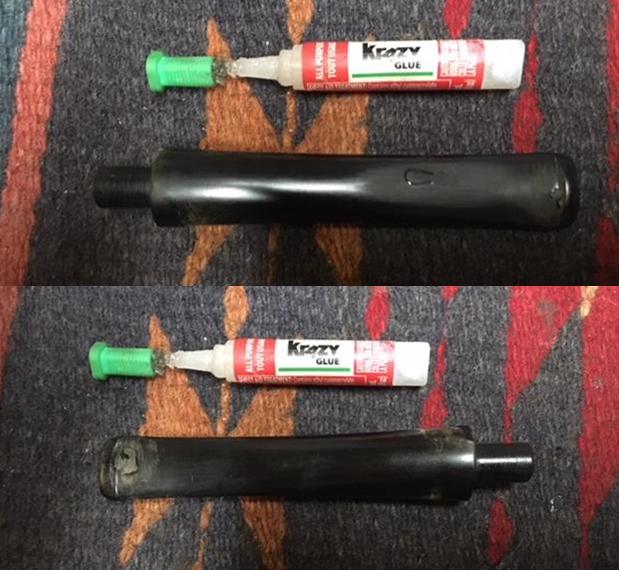 When the repaired areas had dried I used a needle file to smooth out the bubbles of hardened glue. I worked them over until the surface area in front of each button and on the top of the stem was smooth. I sanded them with 220 grit sandpaper to remove the file marks and the scratches in the surface of the vulcanite.
When the repaired areas had dried I used a needle file to smooth out the bubbles of hardened glue. I worked them over until the surface area in front of each button and on the top of the stem was smooth. I sanded them with 220 grit sandpaper to remove the file marks and the scratches in the surface of the vulcanite.
 I polished the stem with micromesh sanding pads – wet sanding with 1500-2400 grit pads and dry sanding with 3200-12000 grit pads. After each pad I wiped the stem down with Obsidian Oil. When I finished with the last pad I gave it a final coat of the oil and let it dry.
I polished the stem with micromesh sanding pads – wet sanding with 1500-2400 grit pads and dry sanding with 3200-12000 grit pads. After each pad I wiped the stem down with Obsidian Oil. When I finished with the last pad I gave it a final coat of the oil and let it dry.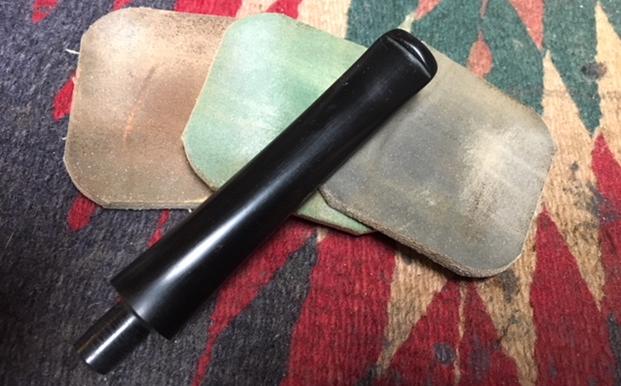

 When I finished polishing the stem and it had dried I put it back on the bowl and took it to the buff. I gently buffed both the rim of the bowl and stem with Blue Diamond. I gave the rim and stem several coats of carnauba wax and buffed them with a clean buffing pad to raise the shine. I buffed the leather with a clean buffing pad as well to give it a shine. I hand buffed the pipe with a microfiber cloth to deepen the shine. This is the second restoration of the pipes Craig sent me. I look forward to the rest of them. I think he will enjoy this one when I send it back. The finished pipe is shown below. Thanks for looking.
When I finished polishing the stem and it had dried I put it back on the bowl and took it to the buff. I gently buffed both the rim of the bowl and stem with Blue Diamond. I gave the rim and stem several coats of carnauba wax and buffed them with a clean buffing pad to raise the shine. I buffed the leather with a clean buffing pad as well to give it a shine. I hand buffed the pipe with a microfiber cloth to deepen the shine. This is the second restoration of the pipes Craig sent me. I look forward to the rest of them. I think he will enjoy this one when I send it back. The finished pipe is shown below. Thanks for looking. 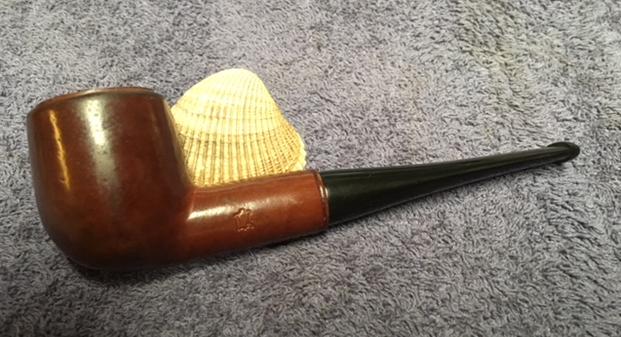

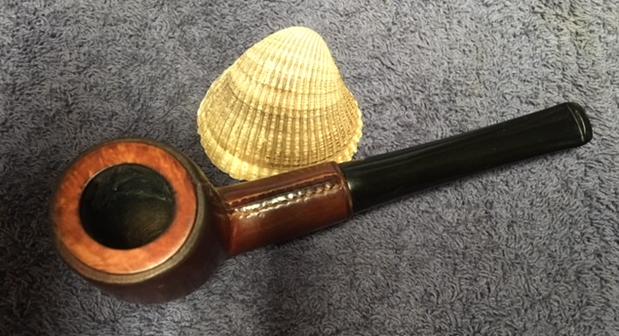

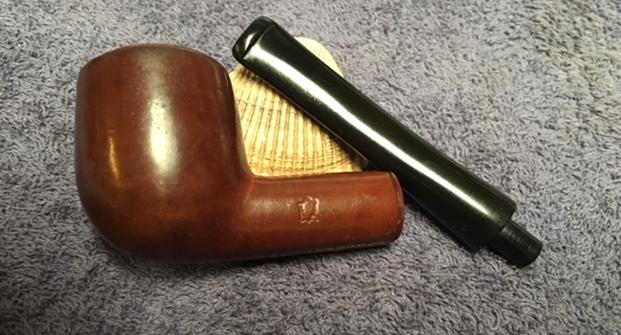
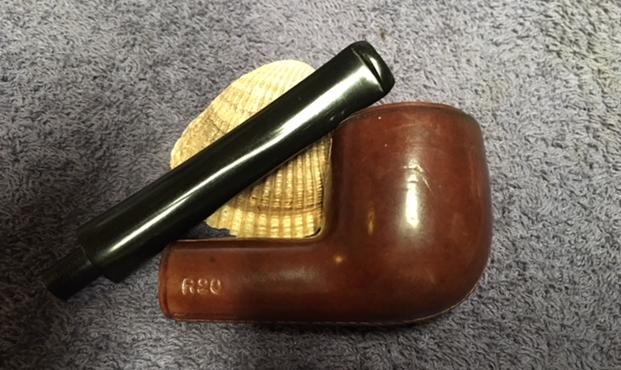

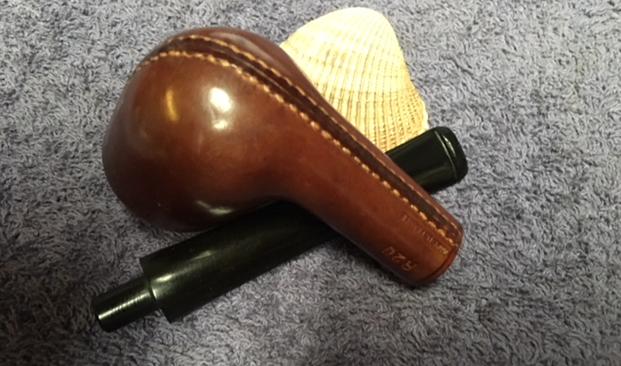




Pingback: rebornpipes
Pingback: Craig’s Pipes #4 – Restoring a Dr. Grabow Starfire 39 | rebornpipes
Pingback: Craig’s Pipes #3 – Restemming and Restoring a Wally Frank Natural Bulldog | rebornpipes
I am positive that the stinger is the same that is in longchamps, so maybe a house pipe produced by longchamp.
LikeLike
Thanks Andrew. I am in agreement regarding the stinger. That is one of the reasons I was thinking Longchamps.
LikeLike